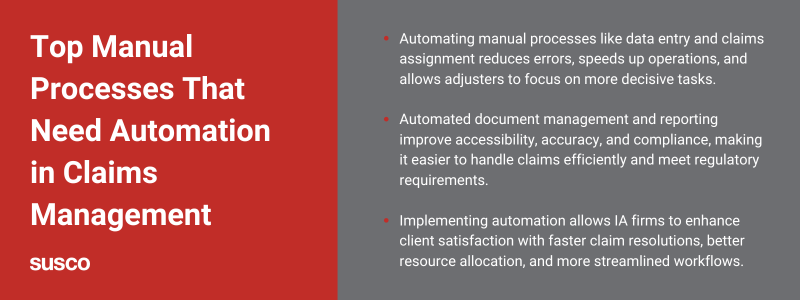
Manual processes have long been challenging in claims management, leading to inefficiencies, errors, and wasted resources. For Independent Adjusting (IA) firms, these outdated workflows slow operations and compromise accuracy, ultimately affecting the bottom line.
Prioritizing automation in claims management is not just a trend—it’s a necessary step toward improving efficiency and accuracy.
Let’s explore a few manual processes that can be automated and provide actionable insights on prioritizing them to save time and resources and reduce costly errors.
Manual Data Entry
Manual data entry is one of the most time-consuming and error-prone tasks in claims management. Adjusters and staff spend countless hours inputting the same information into multiple systems, which increases the likelihood of mistakes and creates unnecessary delays.
Automating this process can save valuable time and ensure that information is consistently accurate across all systems.
Here’s how automating data entry can transform your firm’s operations:
Eliminate human error
Manual data entry leaves room for common mistakes like typos, duplicate entries, or misplaced information, all of which can disrupt the claims process. Automation reduces these risks by standardizing how data is collected and input, ensuring that the information is accurate and complete from the start.
Accelerate data input
Filling out forms and entering data manually is a slow, repetitive process. Automated solutions—such as optical character recognition (OCR), auto-fill forms, and integrated data collection systems—can significantly speed up this task. These tools automatically capture and process claim details, allowing adjusters to move on to higher-priority tasks faster.
Seamless integration with other systems
Automated data entry integrates with other key systems, such as claims management software and estimating platforms. This eliminates the need for duplicate data entry and reduces the back-and-forth that often occurs when working with multiple systems. With seamless integration, data flows freely and is available to all stakeholders in real time.
Consistent data accuracy
Automation enforces rules and validation checks that ensure data is consistently entered in the correct format and without missing critical information. This leads to fewer delays caused by incorrect or incomplete data, helping to move claims through the pipeline more efficiently.
Free adjusters for high-value tasks
By removing the burden of manual data entry, automation allows adjusters to focus on more critical tasks, like analyzing claims, making decisions, and interacting with clients. This increases adjuster productivity and improves client satisfaction by speeding up the claims process.
Prioritizing automation in this area is one of the most effective ways to optimize your claims management processes.
Claims Reporting
Generating reports manually is a major drain on time and resources for IA firms. The process typically involves gathering data from multiple sources, verifying its accuracy, and creating formatted documents that meet internal and external reporting standards. While necessary, manual claims reporting often leads to delays, inconsistencies, and inefficiencies.
Fortunately, automation provides a solution that simplifies report generation and ensures timely, accurate submissions.
Manual reporting presents several challenges for IA firms:
- Time-consuming: Pulling and verifying data across systems slows reporting processes, delaying key insights.
- Prone to errors: The more manual input required, the higher the risk of inaccurate or incomplete data, leading to misguided decisions.
- Inconsistent formatting: Different team members may format reports in varying ways, confusing stakeholders and making it difficult to compare data.
Automating claims reporting, IA firms can address these issues head-on. Automation enables:
- Instant report generation: Reports can be produced in real time, allowing adjusters and managers to access up-to-date data whenever it’s needed.
- Improved accuracy: Automated systems pull data directly from integrated claims platforms, ensuring consistent and error-free information.
- Consistency in reporting: Automated tools ensure that reports follow a standardized format, providing a uniform view of performance metrics and claims data.
Tools for Automated Report Creation and Distribution
Automated reporting tools, such as business intelligence (BI) software, take reporting to the next level by offering:
- Customizable dashboards: Users can create personalized views highlighting key performance indicators (KPIs) and tracking claims in real-time.
- Automated scheduling: Reports can be set to generate and distribute automatically at specified intervals, ensuring stakeholders receive timely updates without manual intervention.
- Easy sharing: These tools allow reports to be easily distributed to internal teams, clients, or other stakeholders, saving time and ensuring all parties can access the latest data.
Automation transforms claims reporting from a tedious, error-prone task into a streamlined, efficient process. By embracing these tools, IA firms can ensure timely, accurate, and consistent reports, helping drive better decision-making and improved client communication.
Claims Assignment and Triage
Manually assigning claims to adjusters can significantly slow down the claims process. When teams rely on spreadsheets, emails, or other manual methods to distribute claims, delays are inevitable. These inefficiencies can lead to uneven workloads, missed deadlines, and slower claim resolutions, ultimately affecting client satisfaction.
Automation tools streamline the assignment process by automatically prioritizing and routing claims based on specific criteria such as urgency, complexity, or adjuster availability. These systems ensure that claims are quickly assigned to the fit adjusters, reducing bottlenecks and minimizing human error.
Susco has solutions
Ready to take the next step in optimizing your firm’s claims management? Contact Susco today for a consultation and discover how our tailored automation solutions can elevate your business.
Susco is a leading technology solutions provider for forward-thinking IA companies.
We build custom, human-centered software that unlocks efficiency and effectiveness throughout the claims cycle. Book a free consultation now to learn more.